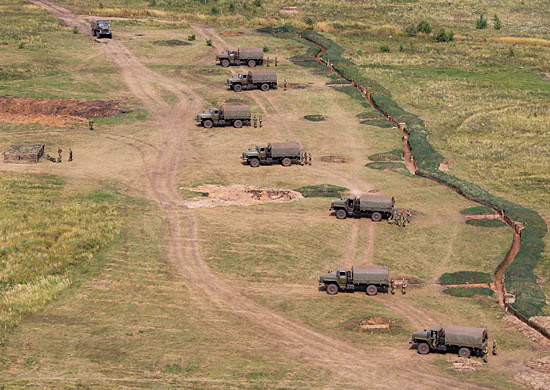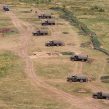
Serdyukov Signals “First Stage” In “Military Reform” Nearing Completion
Publication: Eurasia Daily Monitor Volume: 8 Issue: 191
By:

Russian Defense Minister, Anatoliy Serdyukov, has signaled a shift in emphasis in the effort to reform the Armed Forces. According to Serdyukov the “first stage” of “military reform” concerned organizational changes mostly affecting the staffing of the military, now the “second stage” has commenced, which will focus on implementing the rearmament of the Armed Forces in accordance with the state program to 2020. The defense minister’s comments were made during a meeting with Viktor Baranets, the defense correspondent of Komsomolskaya Pravda; it cannot, however, be characterized as an interview, and none of Serdyukov’s assertions were challenged (Komsomolskaya Pravda, October 6). Setting aside that the minister used the phrase “military reform” despite the current transformation being restricted to defense ministry units, which in itself does not constitute a “military reform,” his claim concerning the near completion of its “first stage” seems remarkable by any standard.
Serdyukov’s comments covered the future introduction of Military Police (MP) responsible, among other duties, for the maintenance of discipline in the units. At this stage, the precise numbers of MP personnel serving in the units is yet to be determined. He made no mention of the potential contribution to discipline stemming from revised plans to introduce professionally trained non-commissioned officers (NCOs), though he fleetingly mentioned them in the context of a marked boost in pay across the Armed Forces planned for next year. The military will receive more money, housing and even S-400 surface-to-air missiles (SAMs) by 2015. The state armament program to 2020 will yield advances in tanks, but may well witness more upgrades to T-72s rather than procuring large numbers of T-90s. Although short on detail, Serdyukov’s message was that the reform was sensible and progressing while better times await the Armed Forces. Nonetheless, the reference by the minister to moving into a new stage of reform will surprise many Russian commanders, not least since there are indications of yet more structural and manpower changes over the next six years at least (Komsomolskaya Pravda, October 6).
There are undoubtedly clear signs of impending manning change, beyond the appearance of a MP structure, linked to devising a new type or standard among NCOs and the plans to vastly boost kontraktniki numbers to 425,000 by January 1, 2017. Of course, the promise of much improved NCOs is not a novelty in the latest reform schemes, but the description of this category of servicemen provided in more detail by Deputy Defense Minister Nikolai Pankov suggests further radical change is envisaged. Pankov still doggedly refers to professional NCOs graduating from Ryazan and entering the units to boost leadership and discipline after completing courses lasting two years and ten months, despite a chronic shortfall in entrants. Conceptually, he refers to a five-tiered structure for NCOs loosely modeled on the US NCO system, and implies additional recruitment sources to swell the numbers (Krasnaya Zvezda, October 6). Were such aspirations to be realized, the Russian Armed Forces would be unrecognizable.
This theme has also been highlighted in recent extensive interviews by the top brass, stating that the NCO plans are not restricted to producing specialists but also extend to leadership. Colonel-General Vladimir Chirkin, the Commander of the Central Military District, outlined the future NCO plans during an interview with Ekho Moskvy. Summarizing his comments, Chirkin’s interviewer said that such an NCO would primarily be a specialist. Chirkin corrected him, and stated that these NCOs will be mainly leaders (Ekho Moskvy, September 22).
A much deeper issue, addressed by Chirkin, relates to changes in tactics linked to the adoption of network-centric warfare capabilities. This is rapidly moving beyond the theoretical realm. Chirkin explained that during the operational-strategic exercise, Tsentr 2011, new combat guideline documents – frequently misreported as amendments to service regulations – were road tested. The new field manuals are being prepared for introduction in 2012. He emphasized the independence of the individual brigade during combat and the abandonment of the tactics of linear operations. In short, the methods and means of conducting warfare are in a process of transformation, with concepts, doctrine and tactics still being worked out (Ekho Moskvy, September 22).
While Chirkin implied that the network-centric approach was influencing tactics and compelling shifts in combat training, Colonel-General Aleksandr Postnikov, the Commander-in-Chief of the Ground Forces, was much more explicit in his assessment of these trends. Not only was Postnikov ready to provide an overview of what network-centric operations might involve at a theoretical level, but he extended this to feeding into almost every area of planning. Network-centric approaches and doctrine would force changes in command and control (C2), tactics, manning and procurement. In finalizing a unified automated C2 system, Postnikov laid the responsibility on the domestic defense industry to design products that will be no worse than those possessed by Russia’s potential enemies (Ekho Moskvy, October 1).
The point, seemingly grasped by members of the top brass, is that while devising new approaches to recruit and train adequate NCOs will result in further manning changes, the much wider and ambitious plans to adopt and develop network-centric capabilities will actually drive future force structure itself. While the General Staff devises a Russian version of network-centric doctrine and the interests of pursuing this course suffuses procurement priorities for conventional weapons systems, a great deal of refinement or further change in the structures can be expected. It will influence the brigade structure, itself still in flux, with plans to develop new Arctic brigades (Rossiyskaya Gazeta, May 18).
A number of conclusions can be drawn from the disparity between the top brass and ministerial level statements. There is a varied level of understanding of network-centric issues and their importance in the transformation process among military personnel, and arguably less appreciation of these complex problems on the part of civilians working in the defense ministry. If Serdyukov really believes “phase one” is over, then he has scant understanding of either the reform he was tasked to manage or about the serious driving force stemming from network-centric approaches to operations. No one in the defense ministry can accurately predict the outcome of the network-centric experiment, let alone calculate the ramifications of its possible failure, or openly identify such a level of uncertainty at the very epicenter of the reform.




